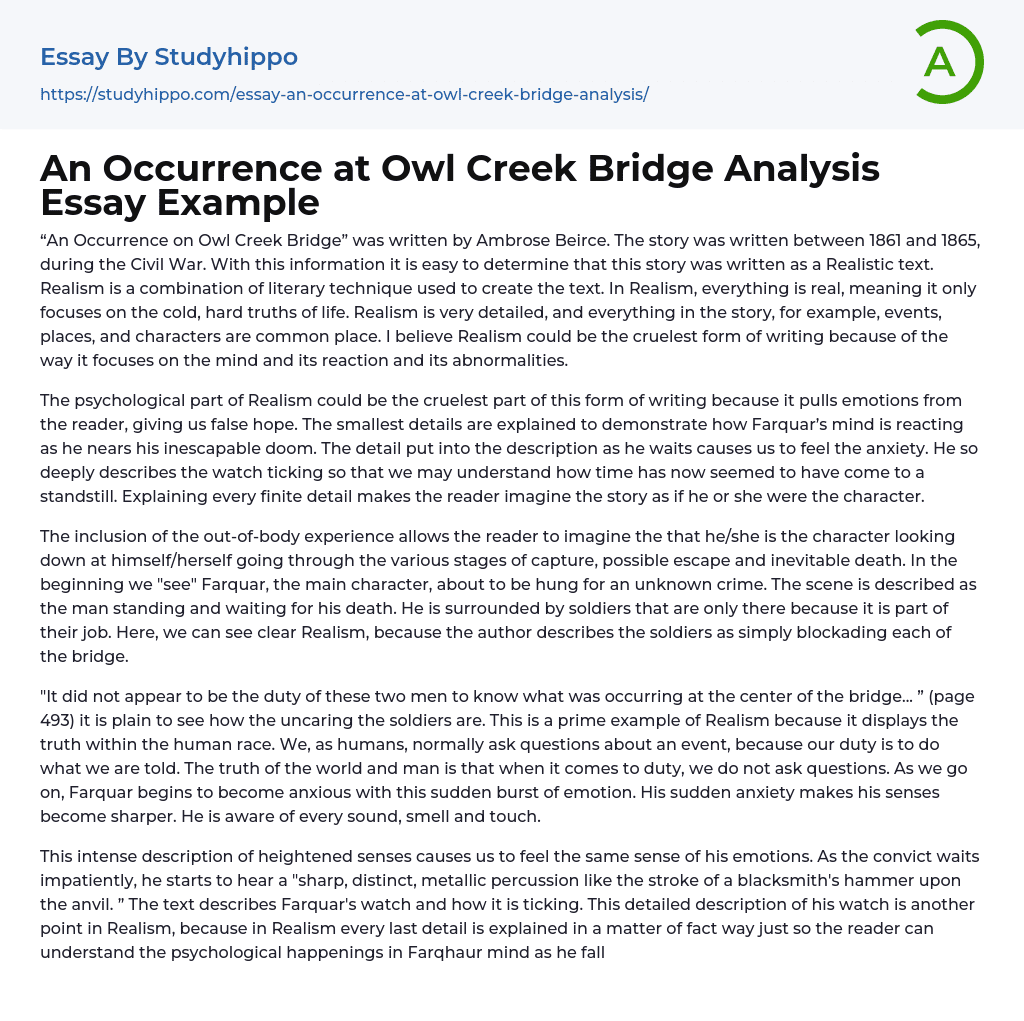The author of "An Occurrence on Owl Creek Bridge" is Ambrose Bierce. This story was written during the Civil War, between 1861 and 1865, which classifies it as a Realistic text. Realism is a literary technique that highlights the depiction of reality, emphasizing the harsh realities of life and providing intricate details about commonly encountered events, places, and characters. In my perspective, Realism can be viewed as one of the most severe forms of writing because it strongly focuses on the mind's reaction and abnormalities.
The psychological aspect of Realism in writing can be the most brutal as it elicits emotions from the reader, providing them with false hope. Every small detail is meticulously explained to reveal the inner workings of Farquar's mind as he approaches his inevitable fate. The extensive description of his wa
...it induces anxiety within us. The elaborate depiction of the ticking watch allows us to grasp how time has seemingly stopped. By laying out every minute detail, the reader is able to envision themselves as the character in the story.
The out-of-body experience inclusion lets the reader envision being the character and observing themselves going through capture, potential escape, and unavoidable demise. Initially, we witness Farquar, the protagonist, on the verge of being hanged for an undisclosed offense. The author depicts the scene as the man standing and awaiting his execution. The soldiers present are merely carrying out their duty, serving as a simple blockade on the bridge. This displays clear Realism.
"It did not seem to be the responsibility of these two individuals to be aware of what was happening at the center of the
bridge...” (page 493) it is evident how indifferent the soldiers are. This is a perfect illustration of Realism as it reveals the reality within the human race. Normally, as human beings, we inquire about an event because our obligation is to obey orders. The truth about the world and humanity is that when it comes to duty, we do not question. As the story progresses, Farquar starts to feel anxious due to this sudden surge of emotion. His anxiety encompasses heightened senses, where he becomes conscious of every noise, scent, and touch.
This passage creates a vivid depiction of heightened senses that elicits the same emotions within us. The convict's apprehensive anticipation is accompanied by the sound of a "sharp, distinct, metallic percussion like the stroke of a blacksmith's hammer upon the anvil." The text then proceeds to extensively describe Farquar's watch, highlighting every minute detail. This meticulous focus on specifics aligns with Realism as it aims to present an accurate account for readers to grasp Farquhar's psychological state as he meets his demise. Part II begins with a scene in an ordinary house where an average family relaxes on their front porch.
The simplicity found in this format contributes to Realism as everything is very ordinary. After a brief description, the protagonist is informed by another person from the south about the location of Union soldiers. Despite not having clear indications of Realism, this passage is well-developed. Lastly, in part III, the author introduces Romanticism, a romanticized form of writing.
Despite being less detailed than Realism, Romanticism vividly portrays people's desires in life as seen in Farquar's desperate thoughts to escape
death. The emotional intensity and intricate depiction of the events that unfold after his fall from the bridge suggest a romantic influence. The unfiltered expression of emotions in the text elicits a powerful reaction from us. Subsequently, as we read further, it becomes evident that his escape is becoming increasingly impossible. From a rational perspective, it is implausible for any man to evade multiple simultaneous bullets.
Naturally, he manages to escape by some sort of magic. However, as he happily returns home to his wife, darkness surrounds him as he approaches his house. The presence of a "happy ending" is an important aspect in Romanticism because it aligns with the central values of this artistic movement. Suddenly, the scene shifts to the bridge where Farquar finds himself swinging back and forth by the neck, abruptly reminding the audience of the harsh realities of life. This malicious portrayal is a characteristic of Realism and serves as a recurring theme intertwined within the story. Ultimately, the story communicates the idea that individual efforts are insignificant.
The absence of a person when they die does not affect the continuation of life. From a Realist perspective, the deceased becomes a forgotten memory and cannot change their fate. This story perfectly represents Realism by providing detailed descriptions of ordinary things without any extraordinary qualities. Realism aims to confront and reveal the uncomfortable truths we often overlook. The harsh reality of death, which we fear more than anything else, exemplifies this.
- Pressure essays
- Confidence essays
- Disgrace essays
- Lost essays
- Harmony essays
- Fairness essays
- Sarcasm essays
- Respect essays
- Responsibility essays
- Empathy essays
- Suffering essays
- Suspense essays
- Fear essays
- Feeling essays
- Loneliness essays
- Ambition essays
- Tolerance essays
- Hope essays
- Inspiration essays
- Kindness essays
- Shame essays
- Desire essays
- Doubt essays
- Grief essays
- Hate essays
- Laughter essays
- Passion essays
- Pride essays
- Forgiveness essays
- Happiness essays
- Humanity essays
- Loyalty essays
- Guilt essays
- Honesty essays
- Betrayal essays
- Need essays
- Boredom essays
- Courage essays
- Regret essays
- Anger essays
- Honor essays
- Honesty Is The Best Policy essays
- Unconscious Mind essays
- 1984 essays
- A Farewell to Arms essays
- A Good Man Is Hard to Find essays
- A Hanging essays
- A Lesson Before Dying essays
- A Long Way Gone essays
- A Rose For Emily essays




